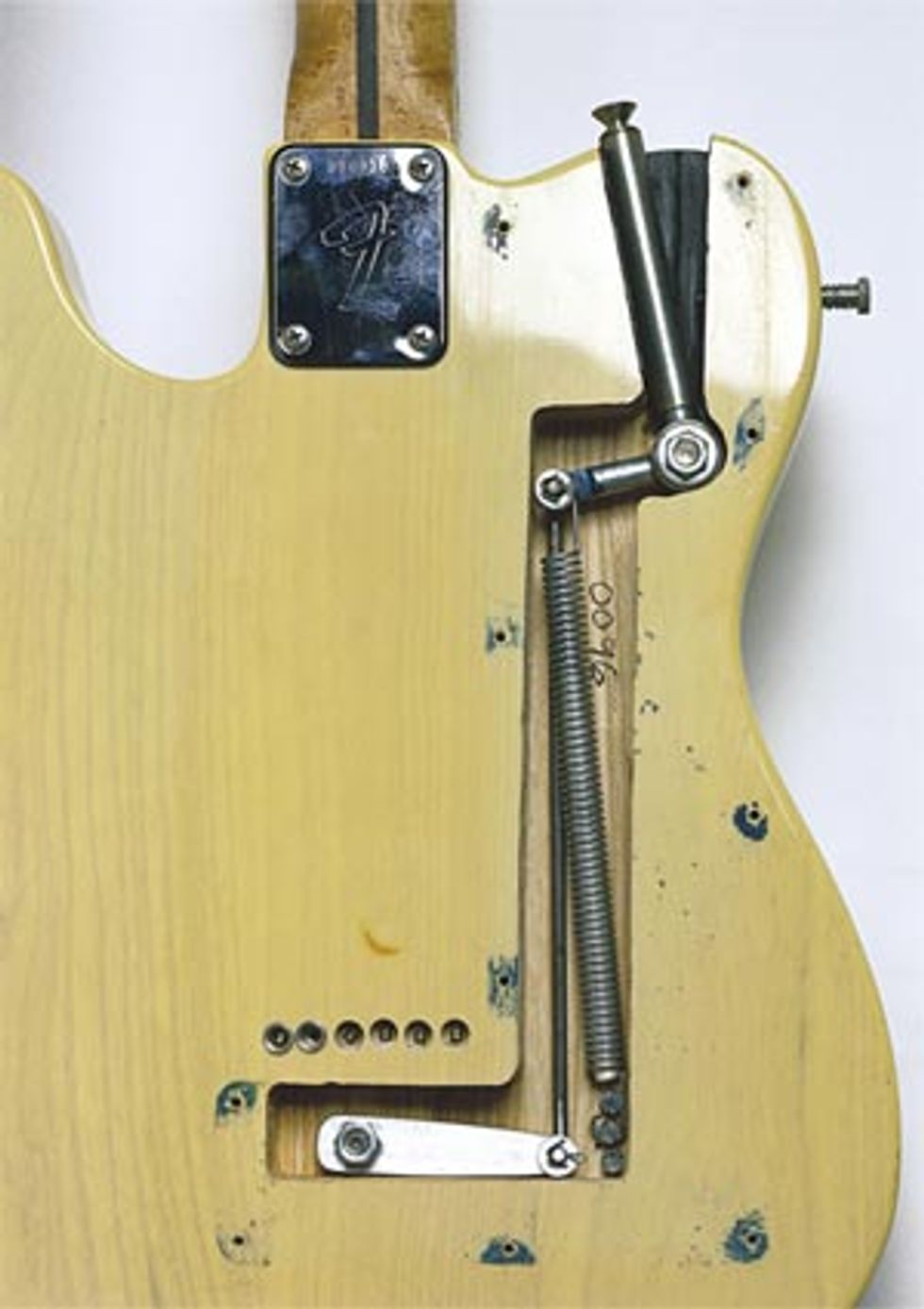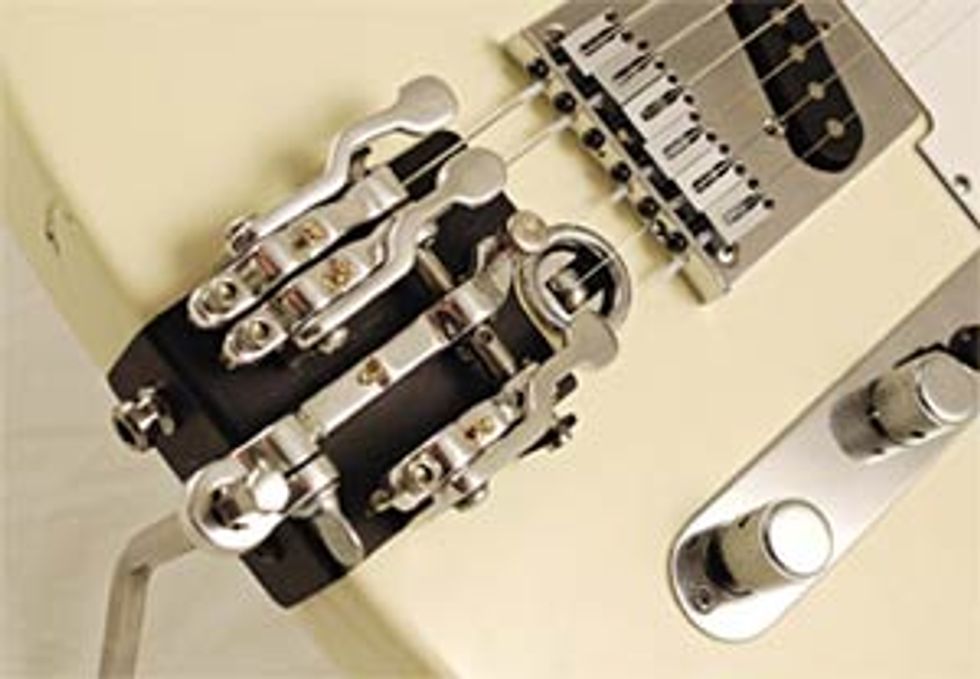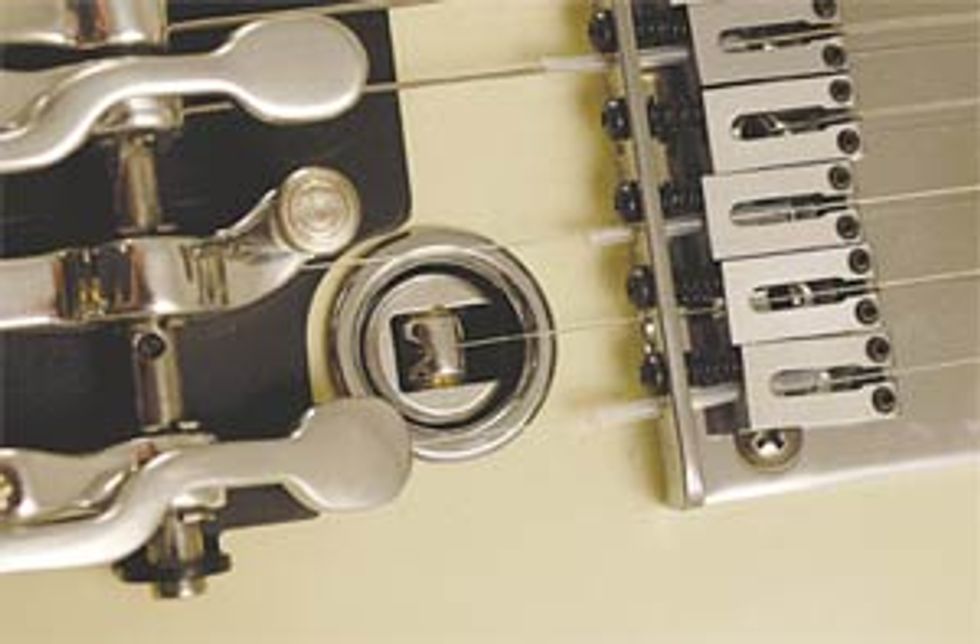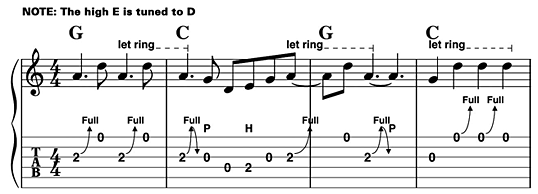 |
|
The benders available today run the gamut from the relatively non-invasive Hipshot – requiring little more than removing and reinstalling the rear strap button and a fresh set of strings – to the Parsons/White system, which requires a skilled installer to remove a good-sized chunk of wood from the body. Other notable systems – such as those from designers Joe Glaser and Charlie McVay – are similar to the Parsons/White in being irreversible propositions for the guitar in question while requiring comparitively less-invasive installations.
Whatever they’re called, in the hands of skilled pickers, bender-equipped axes can melt minds. A nearly imperceptible shrug becomes the basis for a dead-on Ralph Mooney impersonation. A neck being pushed away from the player – looking like a simple strap adjustment – produces an incredible-sounding one-up/one-down bend that is impossible to replicate on a standard guitar. If you’re looking for a new way to wow your bandmates, look no further.
 | |
|
The overall way in which the effect is achieved is common to all of the systems – a mechanical bending of a specific string or strings by a predetermined amount allows the fretting hand to remain stationary (or not). When picking up a B-Bender equipped guitar for the first time, it takes a while to wrap your head around the need to rely on chord shapes instead of familiar modes and scales, but once the light goes on, you’ll be resolving A-shaped add 9 chord fragments to vanilla voicings and back in no time. A short while later – after realizing how much work and effort is needed to truly master a pull-string guitar – you’ll wonder who had the chops to need one in the first place.
That person was Clarence White, a phenom in L.A.''s burgeoning bluegrass scene during the early-sixties. Clarence was fundamental in the development of what we today recognize as "hot" bluegrass picking before reaching his twenties. After nearly single-handedly defining a genre, Clarence began pursuing a studio career on the electric guitar - at the urging of James Burton, no less. The drummer for many of these sessions, as well as fellow future Nashville West and Byrds member, was Gene Parsons.
"One of Clarence''s innovative guitar techniques was to chime the high E or B string and bend it up a full tone by pulling the string down above the nut." Gene explains. "This worked great in open position, but on a particular tune he wanted to play the lick up the neck. He needed another hand to do it." Even though Gene was able to lend his help that time, he was able to foresee the need for something that allowed the player to retain their bending autonomy.
"I knew there had to be a way for Clarence to bend the string himself. I offered to install pedals and cables like those used on pedal steel guitars. Clarence refused because he wanted something that would fit inside his guitar case," Gene recounts. "After a couple of weeks of thinking about it, I came up with the idea of using the shoulder strap to actuate a string-pulling, note-bending mechanism. Not only would it fit into the guitar case, it would actually go inside the guitar! I drew up some plans that incorporated a steel guitar bridge that Sneaky Pete Kleinow procured for me. After a little convincing, Clarence bravely agreed to let me install this contraption in his beloved Telecaster. He said, ''Just don''t show me until it''s done.''" The result of Gene''s hot-rodding skills was the famous maple necked, sunburst Tele with the Plymouth Satellite badge and "Germany" decal adorning its face that routinely delivered seemingly impossible bends. The guitar is now cared for and played by Marty Stuart.
 Today, Gene''s StringBenders are available in three different models. The original Parsons/White, which is the direct descendant of Gene''s first bender, is available directly through stringbender.com for $985 installed on your Telecaster or ASAT. Gene can fit these contraptions to Les Pauls or other types of guitars, as well as install additional features such as the popular long-throw option, for a slight up-charge. There is also a StringBender system available for acoustic guitars and Gene has worked with Meridian Green to develop the Parsons/Green bender.
Today, Gene''s StringBenders are available in three different models. The original Parsons/White, which is the direct descendant of Gene''s first bender, is available directly through stringbender.com for $985 installed on your Telecaster or ASAT. Gene can fit these contraptions to Les Pauls or other types of guitars, as well as install additional features such as the popular long-throw option, for a slight up-charge. There is also a StringBender system available for acoustic guitars and Gene has worked with Meridian Green to develop the Parsons/Green bender. The Parsons/Green system was originally developed for Fender''s B-Bender Tele. The Fender Custom Shop had released a limited edition Clarence White Tele, which, while popular, also proved to be a challenge to manufacture consistently, with the added time needed for proper StringBender installation, equating to high costs for Fender. When faced with the task of coming up with a less-expensive, easier-to-manufacture solution, Gene enlisted the help of Meridian Green to come up with a design which mounted the moving parts on the backplate. Their completed design made installation much less of a chore, with more weight and a less smooth feel than the Parsons/White being the trade-off. While Fender is no longer producing a Bender Tele, Hipshot has picked up the slack by offering the Parsons/Green system for $380, installable by the end-user - provided the end-user is comfortable taking a router to their favorite Tele.
The feel of a Parsons/White StringBender is arguably the most comfortable for novice string-pullers - the front-strap actuated lever retains its familiar position, leaving the guitar''s inherent balance unscathed. Tuning duties are handled by a small screw on the bass bout of the guitar which is easily adjusted with a pick, limiting how far the strap can be pulled, and therefore the pitch at the end of the lever''s travel. The Parsons/Green system will feel right at home to anyone familiar with the Parsons/White system, with some minor variations, such as a scroll-wheel on the back instead of the screw on the guitar''s bass bout. Despite the added heft and not being as smooth as the Parsons/White, the P/G bender makes a fine choice for entering into the bender club.
Both systems have spawned two distinct schools of thought in regards to tuning. One is to tune a few cents sharp, leaving some wiggle room to nudge complex voicings at various spots on the neck into tune. The disadvantage to this approach is losing the point-and-click simplicity of exact tuning. Going the second route - precisely tuning a whole step up - helps when starting out by taking your ear out of the equation, allowing the player to concentrate solely on the new physical movements needed to make the bends flow. This is assuming that you are starting out with a single bender on a single string - B being the most popular, with G quickly gaining ground due to Brad Paisley''s prowess.
Another thing to be mindful of when strapping on a bender-equipped guitar is how much weight you are (perhaps unintentionally) placing on your neck via your fretting hand, making in-tune open D and A chords a challenge. Watch Marty Stewart or Brad Paisley''s posture a little more closely the next time you see them on CMT - they let the strap hold the guitar, making sure to avoid inadvertent pushes or pulls on the neck. This tends to be more of an issue for pickers who like to wrap their thumbs over the neck to fret notes, but is easily overcome once the player becomes comfortable with letting the guitar simply hang there.
 Shake Those Hips
Shake Those HipsBut what if you''ve got more motion in your hips than in your shoulders? Hipshot offers the Hipshot String Bender on its own for folks who like to dip their toes in the water before they dive in. Designed by David Borisoff, the Hipshot consists of an outboard system that sits on a plate mounted behind the guitar''s bridge via the rear strap button. The Hipshot is unique in that it provides full pull-string functionality with no permanent modification to your guitar and is available with an assortment of palm levers and toggle tuners in a modular configuration. This design gives the user the final say in which strings go where, ultimately allowing “Honky Tonk Woman,” “Cinnamon Girl,” and “Mama Tried” to co-exist peacefully on a set list without any undue stress or the need to constantly re-tune or swap axes. While it doesn’t feel as integrated as the other more invasive systems, the Hipshot delivers impressive string-bending capabilities. The “hip lever” is operated via a bar mounted at a right angle to a lever, to which the bended string is mounted; a thumbscrew is provided for tuning chores. The device is engaged by either pushing the neck away or swaying your hip, hence the “Hipshot” moniker.
The toggle-tuner’s ability to effortlessly shift from standard to open G to drop D tunings cannot be overstated. In addition to changing tuning from one song to the next is the ability to switch to drop D for the bridge of a tune and back to standard for the chorus. Although much of the same capability is available by installing Scruggs pegs – banjo tuners with two stops adjusted by set screws to provide two tunings on the same string – the toggle tuners require a much simpler and less invasive installation, proving less fussy for guitar duties.
Although the Hipshot can initially seem a little awkward, the process quickly becomes second nature. Ease of use, low-cost and simple installation counter a notchy feel and added difficulty when trying to hit half-step, in-between bends (compared to other systems), although both the hip lever and palm levers can be specifically set for half-step bends if desired. But there is no mistaking that the Hipshot is a highly functional, fun and easy solution for turning your guitar into a genuine pull-string machine. Although it is often thought of as the gateway drug to more expensive and integrated systems, the Hipshot is an extremely viable end-all/beall solution. With high-profile pickers like Will Ray and Dave Edmunds putting them to good use, it would be wrong to assume the Hipshot is a toy. Additionally, the Hipshot may be the only solution for guitarists who suffer from commitment-phobia yet want to cop some pedal steel licks.
For the consummate string bender, the option of using both Hipshot and P/G systems in one guitar is intriguing. In this setup, the Hipshot actuates the G string while the Parsons/Green handles the B bending chores, delivering the familiar push-down-for-B, push-away-for-G set up. With toggle tuners installed on both E strings and the A, open G tuning is achievable in a grand total of three seconds. The combination of both systems on one guitar is less schizophrenic than one would think, offering up surprising flexibility, with the Parsons/Green and Hipshot systems working relatively seamlessly in tandem.
| The Lick That Started It All Early in 1967, Gene Parsons had the foresight to bring his mono, reel-to-reel tape recorder from home to record his combo playing at a local El Monte, California club called the Nashville West. The band, consisting of Gib Guilbeau on vocals, Wayne Moore on bass, Gene on skins and Clarence White on electric guitar, was also called Nashville West. In 1978, this recording was released on vinyl as Nashville West on the Sierra-Briar Records label, and eventually showed up on CD in 1997 on Sierra Records. The first track on the CD is called – what else? – “Nashville West,” and it demonstrates the technique that ultimately spawned Gene’s development of the StringBender. With the high E string tuned down to D, Clarence pulls off a behind the nut bend up to E the second time through the main theme. The following is an extremely simplified example of the Clarence’s technique. His sense of time is unparalleled, so the main thing you should take away from this is how something as simple as a whole step bend behind the nut can make your guitar sit up within a part, as well as offer a little taste of what is possible with a proper, bender-equipped axe. |

Glaser’s Bender
No overview on pull-string systems would be complete without mentioning Glaser benders. Developed by Joe Glaser in the late-seventies, his benders use an ingenious installation method requiring several small routes rather than one large one to lessen the removed wood’s impact on the instrument’s original sound. These routes are located under the pickguard, neckplate, and bridge. There is also a single, small diameter (3/8”) hole drilled through the length of the guitar. The small lever actuating the device resides on the neck plate, altering the guitar’s strap location, although the change in feel is fairly negligible. According to Joe, he places the lever here because it results in a more effective pull due to the straighter angle of the strap in relation to the lever. Accordingly, the Glaser system is the smoothest of the bunch, featuring a screw at the guitar’s lower bout for adjusting the lever’s resistance, allowing the player to select from breath-and-it’ll-go-sharp easy to my-shoulder’s- sore hard and all points in between.
Glaser’s ingenious and unobtrusive installation leaves little doubt why players like Jimmy Olander and Brent Mason rely on his benders. With smooth, effortless operation, the only negatives that can be leveled at the Glaser system are the change in feel due to the strap’s new placement and installation waiting times. Joe installs the bender systems in his shop, but benders are just one of the items Glaser’s business handles. The resulting turn-around times can end up being counted in months rather than weeks.
The biggest difficulty when trying to choose a pull-string system of your own is lack of availability. Since Fender quit producing the B-Bender Tele, the question of where to try one out has become even more pertinent. Fortunately – or perhaps unfortunately – pull-string systems aren’t for everybody, so they often pop up used. Keeping an eye on TDPRI.com’s classified section and eBay can turn up the occasional deal. Putting the word out on your favorite Tele forums and dutifully perusing your local Craigslist classifieds can also help unearth hidden gems.
If sleuthing around isn’t your cup of tea, the Hipshot system is hard to beat and can easily deliver journeyman-level bender fun without demolishing the Christmas club funds. By the same token, if you have the extra cash and don’t mind jumping right in, give Gene or Joe a buzz and tell them what you’re looking for. Both are passionate about what they do – choose the one who speaks to you.
| Bender Resources If you’d like to learn more about these pull-string systems, check out the following websites.
|






![Rig Rundown: Russian Circles’ Mike Sullivan [2025]](https://www.premierguitar.com/media-library/youtube.jpg?id=62303631&width=1245&height=700&quality=70&coordinates=0%2C0%2C0%2C0)

















